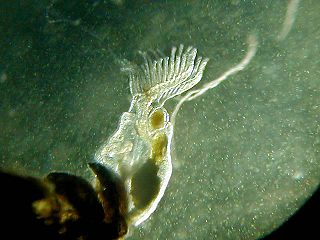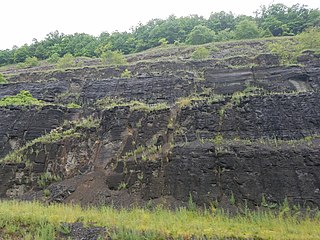
Electron beam computed tomography (EBCT) is a specific form of computed tomography (CT) in which the X-ray tube is not mechanically spun in order to rotate the source of X-ray photons. This different design was explicitly developed to better image heart structures that never stop moving, performing a complete cycle of movement with each heartbeat.

The lophophore is a characteristic feeding organ possessed by four major groups of animals: the Brachiopoda, Bryozoa, Hyolitha, and Phoronida, which collectively constitute the protostome group Lophophorata. All lophophores are found in aquatic organisms.

Tentaculites is an extinct genus of conical fossils of uncertain affinity, class Tentaculita, although it is not the only member of the class. It is known from Lower Ordovician to Upper Devonian deposits both as calcitic shells with a brachiopod-like microstructure and carbonaceous 'linings'. The "tentaculites" are also referred to as the styliolinids.
Eduvard "Eddie" Krncevic is an Australian retired football player and manager who played as a forward.

YouTube is an American online video sharing platform owned by Google. Accessible worldwide, YouTube was launched on February 14, 2005, by Steve Chen, Chad Hurley, and Jawed Karim, three former employees of PayPal. Headquartered in San Bruno, California, United States, it is the second-most visited website in the world, after Google Search. As of January 2024, YouTube has more than 2.7 billion monthly users, who collectively watch more than one billion hours of videos every day. As of May 2019, videos were being uploaded to the platform at a rate of more than 500 hours of content per minute, and as of 2021, there were approximately 14 billion videos in total.

Spirorbis is a genus of very small polychaete worms, usually with a white coiled shell. Members of the genus live in the lower littoral and sublittoral zones of rocky shores. Spirorbis worms usually live attached to seaweeds, but some species live directly on rocks, shells or other hard substrates. Spirorbis was once thought to have a fossil record extending back into the Early Paleozoic, but now all pre-Bathonian spirorbins are known to be microconchids. The earliest members of genus appeared in the Miocene, but Oligocene finds may also be possible. The genus contains the following species:
Kaministiquia is a community in the Canadian province of Ontario, located in the Thunder Bay District on Highway 102 approximately 30 kilometres west of Thunder Bay. A designated place served by a local services board, Kaministiquia had a population of 587 in the Canada 2006 Census.
The UGM-89 Perseus was a proposed U.S. Navy submarine-launched anti-ship (AShM) and anti-submarine (ASW) cruise missile that was developed under the Submarine Tactical Missile (STAM) project, which was also referred to as the Submarine Anti-ship Weapon System (STAWS). This missile system was to be the centerpiece for a proposed third-generation nuclear-powered cruise missile submarine championed by then-Vice Admiral Hyman G. Rickover, the influential but controversial head of the Navy's nuclear propulsion program.

The order Microconchida is a group of small, spirally-coiled, encrusting fossil "worm" tubes from the class Tentaculita found from the Upper Ordovician to the Middle Jurassic (Bathonian) around the world. They have lamellar calcitic shells, usually with pseudopunctae or punctae and a bulb-like origin. Many were long misidentified as the polychaete annelid Spirorbis until studies of shell microstructure and formation showed significant differences. All pre-Cretaceous "Spirorbis" fossils are now known to be microconchids. Their classification at the phylum level is still debated. Most likely they are some form of lophophorate, a group which includes phoronids, bryozoans and brachiopods. Microconchids may be closely related to the other encrusting tentaculitoid tubeworms, such as Anticalyptraea, trypanoporids and cornulitids.

Tentaculita is an extinct class of uncertain placement ranging from the Early Ordovician to the Middle Jurassic. They were suspension feeders with a near worldwide distribution. For a more thorough discussion, see Tentaculites.
Trypanoporida is an extinct order of encrusting animals within Class Tentaculita, which were common in Devonian oceans. Their affinity is unknown; they have been placed among worms and corals. They appear to be closely related to other taxa of uncertain affinity, including the microconchids, cornulitids, and tentaculitids. Spirally coiled trypanoporids (Devonian) were most likely derived from the geologically older microconchids.

Anticalyptraea is a fossil genus of encrusting tentaculitoid tubeworms from the Silurian to Devonian of Europe and North America . Anticalyptraea commonly encrust various invertebrate fossils such as stromatoporoids, rugose corals, bryozoans, brachiopods and crinoids, but they can also be common on the hardgrounds.

Lois Eleanor Delander was Miss America in 1927.

Palaeoconchus is a genus of microconchid tubeworms. Their tubes have pseudopunctae penetrating the tube wall. Tubes lumen is smooth. Palaeoconchus occurs in the Late Ordovician of Baltica and Avalonia. In the Devonian it had a global distribution.

Helicoconchus is a microconchid genus that occurs in the Lower Permian of Texas. It forms small reef-like bodies of tubes branching from a common origin. The impunctate tubes are greatly elongated for microconchids and have occasional diaphragms with central pits. The tubes branch in two ways: budding from the tube wall and binary fission. They lived in shallow, normal marine environments.

The Bluestone Formation is a geologic formation in West Virginia. It is the youngest unit of the Upper Mississippian-age Mauch Chunk Group. A pronounced unconformity separates the upper boundary of the Bluestone Formation from sandstones of the overlying Pennsylvanian-age Pocahontas Formation.

Homeobox protein CDX-4 is a protein that in humans is encoded by the CDX4 gene. This gene is a member of the caudal-related homeobox transcription factor family that also includes CDX1 and CDX2.











